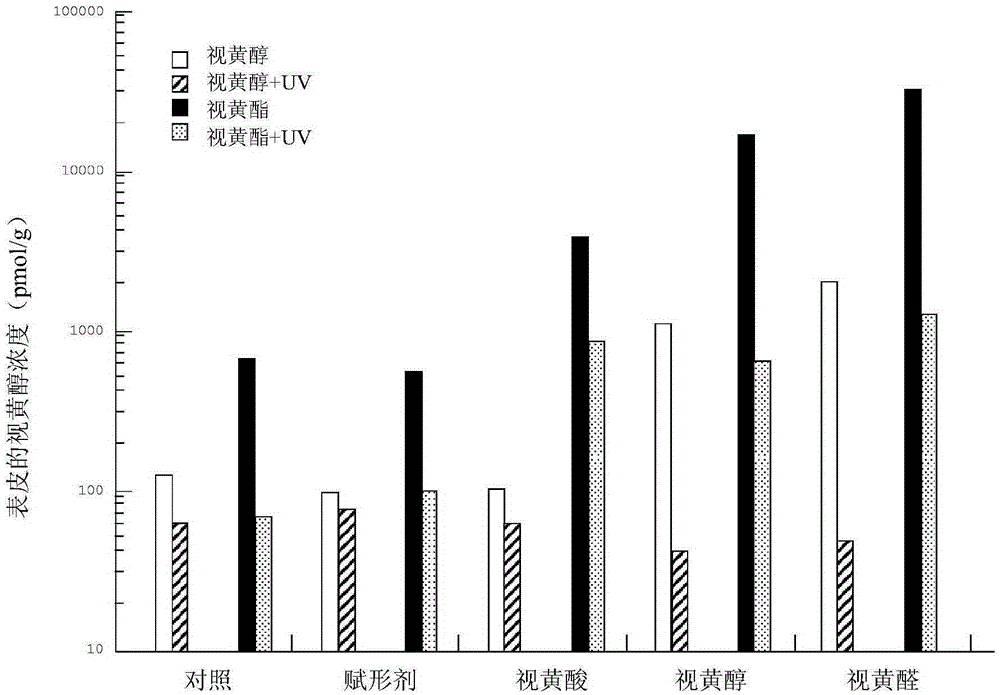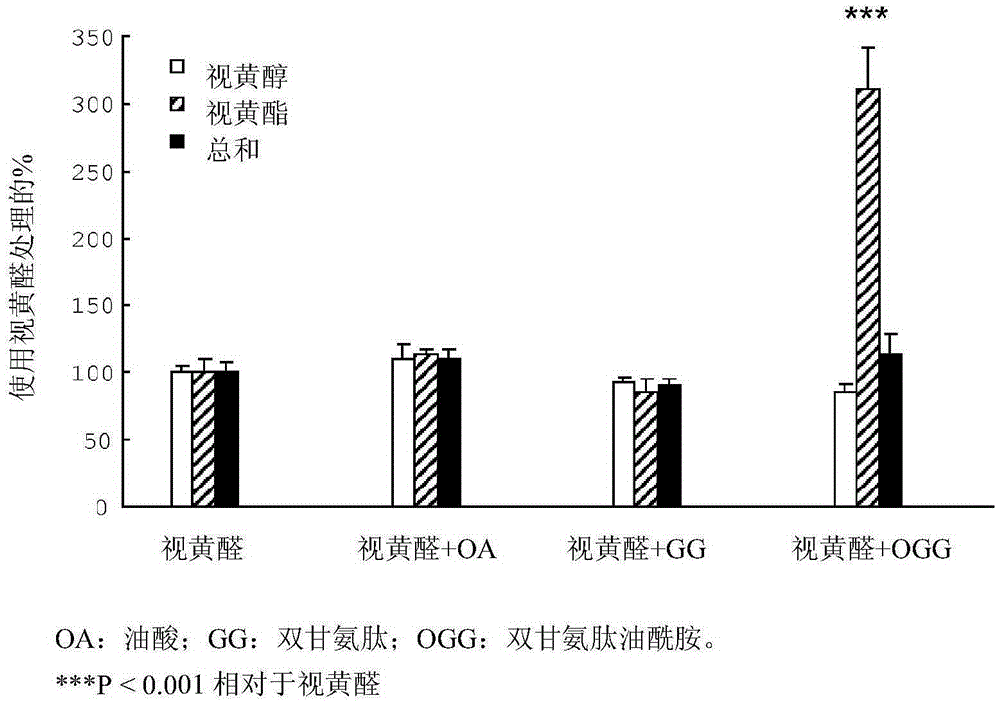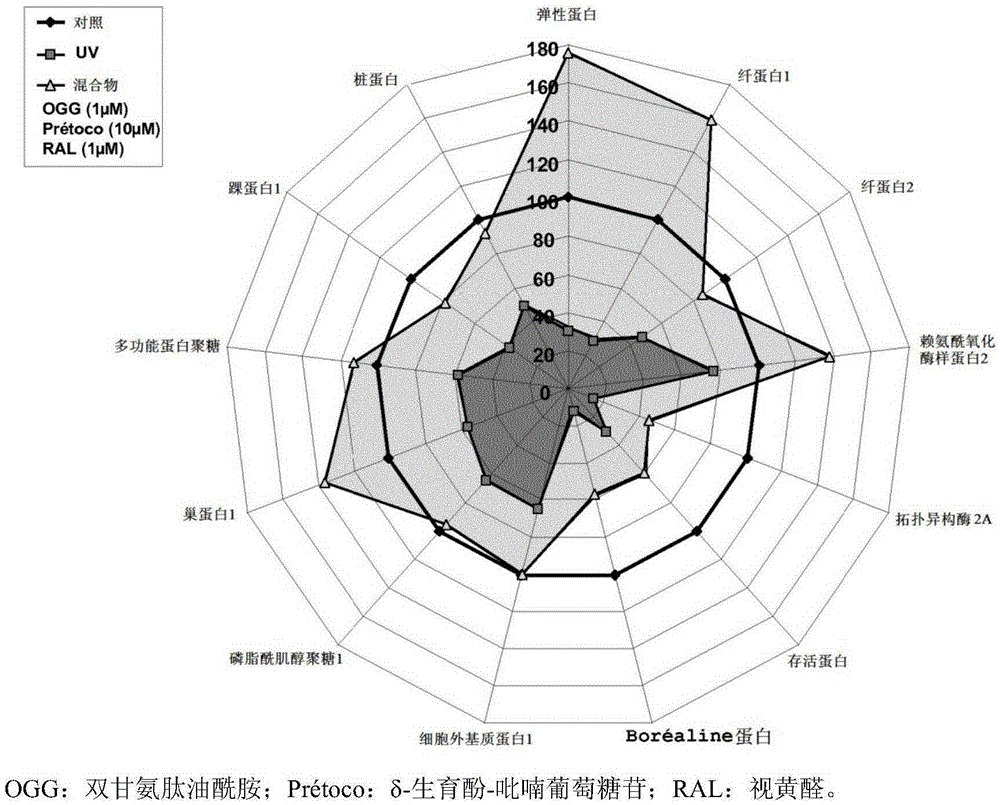Cosmetic or dermatological compositions combining retinaldehyde and glycylglycine oleamide, and the cosmetic or dermatological uses thereof
A glycine peptide oleamide, dermatological technology, applied in cosmetic preparations, cosmetics, skin diseases and other directions, can solve problems such as weak carcinogenicity
- Summary
- Abstract
- Description
- Claims
- Application Information
AI Technical Summary
Problems solved by technology
Method used
Image
Examples
Embodiment 1
[0065] Depletion induced by UV radiation is prevented by pretreatment with topical retinoids (Tran et al., Photochem. Photobiol. 73(4):425-431, 2001).
[0066] The study was performed in hairless mice. Topical application of retinoid at 0.05% for 7 days followed by UVB radiation (1J / cm 2 ). The epidermis was tested for retinoids 24 h after irradiation.
[0067] The results are shown in figure 1 , with the title: Prevention of UV-induced depletion by pretreatment with topical retinoids.
[0068] Retinaldehyde and retinol prevent light-induced depletion of epidermal retinyl esters by loading the epidermis with retinoids. Thus, retinoic acid prevents light-induced retinoid depletion without providing any substrate, only by inducing lecithin retinol acyltransferase.
[0069] Conclusions: Retinaldehyde had the best profile in this study of light-induced retinoid depletion.
Embodiment 2
[0071] Regulation of retinoid-induced retinyl esters in keratinocytes.
[0072] The study was performed on keratinocytes A431 in culture. In fact, in these cells, no endogenous retinoids were measured. Retinoid must be pre-applied to measure cellular retinoid. Retinoids were measured by HPLC. Incubation was carried out in medium for 24 to 72 h in the presence of various reagents or combinations of reagents dissolved in 1% ethanol.
[0073] Production of retinoids in keratinocytes is shown in the table below. These are mean values expressed in pmol / mg protein.
[0074] Table 1
[0075]
[0076]
[0077] OA: oleic acid; GG: glycylglycine; OGG: glycylglycine oleamide; ROL-Pal: retinyl palmitate; RAL: retinal.
[0078] This experiment offers the possibility to establish that retinal induces a series of retinyl esters. Glycyl oleamide significantly increased these retinaldehyde-induced retinyl esters, demonstrating a true synergy through this link. Retinyl palmitate...
Embodiment 3
[0081] Effects of the combination of retinal and glycylglycine oleamide and delta-tocopherol-glucopyranoside on human dermal fibroblasts irradiated with UVA.
[0082] The aim of the study was to evaluate the protective properties of these three active substances prior to irradiation of fibroblasts.
[0083] The study was performed on normal human dermal fibroblasts, which were seeded in 12-well plates and cultured in culture medium for 24 hours.
[0084] To probe for a protective effect, the medium was replaced with a matrix containing or not (control) a mixture of the products to be tested and the cells were incubated for 24 hours. At the end of the pre-incubation, the substrate was replaced with compound-free irradiation substrate (milieud'irradiation), followed by UVA (20J / cm 2 ) irradiated cells or not irradiated (non-irradiated control). At the end of the irradiation, the matrix was replaced with the test matrix (milieud'essai) and the cells were incubated for 48 hours....
PUM
 Login to View More
Login to View More Abstract
Description
Claims
Application Information
 Login to View More
Login to View More - R&D
- Intellectual Property
- Life Sciences
- Materials
- Tech Scout
- Unparalleled Data Quality
- Higher Quality Content
- 60% Fewer Hallucinations
Browse by: Latest US Patents, China's latest patents, Technical Efficacy Thesaurus, Application Domain, Technology Topic, Popular Technical Reports.
© 2025 PatSnap. All rights reserved.Legal|Privacy policy|Modern Slavery Act Transparency Statement|Sitemap|About US| Contact US: help@patsnap.com



